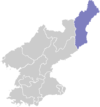Chongjin
| Ch'ŏngjin City | |
|---|---|
 NASA World Wind image of Ch'ŏngjin. |
|
| Korean name | |
| Chosŏn'gŭl | 청진시 |
| Hancha | 淸津市 |
| McCune–Reischauer | Ch'ŏngjin-si |
| Revised Romanization | Cheongjin-si |
| Statistics | |
| Population (2006 (est.)) | 327,000 |
| Government | Capital of North Hamgyŏng; former Directly Governed City* |
| Administrative divisions | 7 wards ("Kuyŏk") |
| Region | Kwanbuk |
| Dialect | Hamgyŏng |
| Notes | |
|
|
Ch'ŏngjin (청진시, Ch'ŏngjin-si; Korean pronunciation: [tɕʰɔŋdʑin-ɕi]) is the capital of North Korea's North Hamgyŏng Province and the country's third largest city. From 1960 to 1967 and again from 1977 to 1985, Ch'ŏngjin was administered separately from North Hamgyŏng as a Directly Governed City (Chikhalsi). Prior to 1960, from 1967 to 1977, and since 1985, the city has been part of the North Hamgyŏng Province.
Contents |
Administrative divisions
Ch'ŏngjin is divided into 7 wards ("Kuyŏk").
- Ch'ŏngam-guyŏk (청암구역; 青岩區域)
- P'ohang-guyŏk (포항구역; 浦港區域)
- Puyun-guyŏk (부윤구역; 富潤區域)
- Ranam-guyŏk (라남구역; 羅南區域)
- Sinam-guyŏk (신암구역; 新岩區域)
- Songp'yŏng-guyŏk (송평구역; 松坪區域)
- Sunam-guyŏk (수남구역; 水南區域)
Originally Chongjin was only a small fishing village, located in northeastern Korea. In 1908, the Japanese, in order to facilitate a sea route for the northeast Chinese and Korean resources, opened this small fishing village as a trade port. In 2003, the government of North Korea formed a northeast Korean trade port here. The People's Republic of China and Russia have set up their Consulates in Chongjin. It is unique for a North Korean city to have a foreign consulate. Chongjin is the administrative centre of the North Hamgyong Province.
Geography
Chongjin is located in the northeast of North Korea, in North Hamgyong Province, near the East Korea Bay in the Sea of Japan (East Sea of Korea). Chongjin divides into 7 districts: the Central Business District expands to the south, and the coast section is near the lively Sosongchon River mouth. The city is 50 miles from the Chinese border, and its proximity is allowing a growing market of Chinese goods sold on the streets. Outside of the capital Pyongyang it has one of the largest markets for goods in the country.
Economy
Chongjin is one of the DPRK’s important steel and fiber industry centers. It has a shipyard, locomotive plant, machinery, and rubber factory. Near the port area are the Chongjin Steel Co., Chemical Textile Co., May 10 Coal Mine Machinery Factory and Kimchaek Iron & Steel; however industrial activities in the city have been severely handicapped due to a lack of resources. Because of the heavy concentration of industries in the area, Chongjin is also the DPRK's air pollution black spot. With the collapse of the Soviet Union and following shortage of oil to generate electricity, many factories have stopped running. One of the first senior U.N. officials permitted to visit the area, Tun Myat, observed in 1997 when the North Korea economic crisis reached its peak, "Chongjin was like a forest of scrap metal, with huge plants that seem to go on for miles and miles that have been turned into rust buckets. I've been all over the world, and I've never seen anything quite like this." The area has little arable land, so the famine in the 1990s hit the residents of Chongjin particularly hard. During the late 1990s, the city's residents experienced some of the highest death rates from famine.
Transport
Main Station of Wonson-Rason Railway and Chongjin-Rason Railway, electric railway connect Rason and capital Pyongyang. Chongjin Airport is equipped with a 2 km runway, military and civilian dual purpose air station (CHO); Also may take Chaoyangcun International Airport (YNJ), People's Republic of China. Moreover, the DPRK planned to upgrade an old airport near Hamhung in 2003, so that it would have a 4 km runway, and would act as the second international airport. However, it is still not yet completed. The first international airport is in Pyongyang and is called Sunan International Airport (FNJ).
Urban transit
Chongjin is the only city in North Korea other than Pyongyang to operate the trams, which are all second-hand from Pyongyang. Originally, it was planned to become a 32 km system, but only phase 1 (6 km) and phase 2 (7 km) were completed. Phase 3 (8 km) was supposed to be completed, but was not due to lack of funds. Also, due to electricity shortages, the trams run infrequently. Besides trams, trolley buses also operate, but these are operated at an interval of two hours. Private taxis do not exist, personal cars are extremely rare, and owning a bicycle is a luxury.
Culture
It has Chongjin University of Technology, Chongjin Mine University, Chongjin University of Education no. 1, University of Education no. 2, Chongjin University of Agriculture, Chongjin University of Medicine and Chongjin University of Light Industry: altogether 7 higher education institutes and an aquatic product research centre.
Famous scenic sites include hot springs, and Mt. Chilbosan. It also has a zoo, but currently has no animals in it. Chongjin's most famous product is processed squid. The city is also home to the football team, the Ch'ŏngjin Chandongcha.
Chongjin was the subject of an extensive profile by Barbara Demick of the Los Angeles Times in 2005,[1] and featured heavily in a 2009 book by the same author entitled Nothing to Envy: Real Lives in North Korea, which was largely based upon the stories of refugees who had escaped from Chongjin to South Korea.[2]
References
- ↑ Demick, Barbara (3–4 July 2005). "Glimpses of a Hermit Kingdom". Los Angeles Times. http://articles.latimes.com/keyword/chongjin-north-korea.
- ↑ Demick, Barbara (2010). Nothing to Envy: Real Lives in North Korea (UK ed.). Granta Publications. ISBN 9781847081414.
See also
- List of Korea-related topics
- List of cities in North Korea
- Geography of North Korea
|
|||||||||||||
